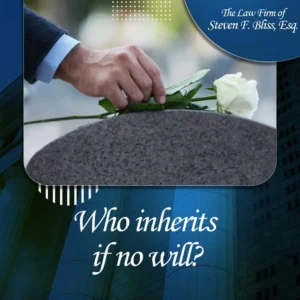In California, when a person dies without a will, their estate is distributed according to the state’s intestacy laws. These laws, found in the California Probate Code, determine who inherits based on the deceased’s closest surviving relatives. The absence of a will means that the decedent’s personal wishes are not considered, and the court follows a strict legal hierarchy. Understanding how intestate succession works is essential for families to anticipate outcomes and prevent disputes.
 The first in line to inherit are the surviving spouse and children. California is a community property state, meaning that the surviving spouse automatically retains their one-half interest in community property. The decedent’s half of the community property generally passes to the surviving spouse as well. Separate property, however, is divided differently. If there are no children, the spouse inherits all separate property; if there is one child, the spouse and child split the separate property; if there are two or more children, the spouse inherits one-third, and the children share the remaining two-thirds.
The first in line to inherit are the surviving spouse and children. California is a community property state, meaning that the surviving spouse automatically retains their one-half interest in community property. The decedent’s half of the community property generally passes to the surviving spouse as well. Separate property, however, is divided differently. If there are no children, the spouse inherits all separate property; if there is one child, the spouse and child split the separate property; if there are two or more children, the spouse inherits one-third, and the children share the remaining two-thirds.
When no spouse or children survive, the estate passes to other relatives according to California’s next-of-kin rules. Parents are next in line, followed by siblings, nieces and nephews, and more distant relatives such as grandparents, aunts, and uncles. If no relatives exist, the estate eventually escheats to the State of California. This ensures property does not remain ownerless, but it also highlights the importance of estate planning to avoid unintended outcomes.
Special rules apply to blended families. Children from prior marriages are treated the same as children from the current marriage under intestacy law, inheriting an equal share of the estate. Stepchildren, however, are not entitled to inherit unless they were legally adopted. This can create tension in families where stepchildren were raised as part of the household but are excluded under strict legal definitions. Planning with a will or trust avoids such inequities.
| Survivors | Community Property | Separate Property |
|---|---|---|
| Spouse only | 100% to spouse | 100% to spouse |
| Spouse + 1 child | 100% to spouse | 50% spouse / 50% child |
| Spouse + 2+ children | 100% to spouse | 1/3 spouse / 2/3 divided among children |
| No spouse, children alive | N/A | 100% to children equally |
| No spouse, no children | N/A | Parents, siblings, or next of kin inherit |
Practical complications often arise when there is real estate involved. Without a will, selling or transferring property may require a full probate process, which can be lengthy and costly. Additionally, disputes often occur when multiple heirs inherit property together, such as siblings inheriting a family home. Creating a trust during life can prevent these challenges by specifying how real estate should be managed or distributed.
In conclusion, when someone dies without a will in California, inheritance follows a strict order under intestacy law. Spouses and children inherit first, with parents, siblings, and extended relatives next in line. Without heirs, the estate reverts to the state. While the law provides a default system, it does not account for personal wishes or unique family dynamics. Californians can add real value to their estate planning by creating wills and trusts that prevent disputes, reduce probate costs, and ensure assets pass according to their intentions.






